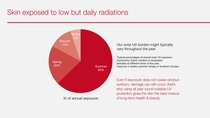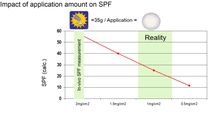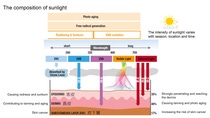Secrets behind sun protection
Sun protection is a hot topic during summer. While some consumers think that such protection means merely the application of sunscreen, in fact there are much knowhow behind. Do you know the following facts about sun protection?
.jpg)
No. Although sun radiation is strong in summer, we are exposed to varying levels of ultraviolet (UV) radiation every day during the different seasons of the year. Even if such exposure does not cause obvious sunburn, damage still occurs.
Some consumers may think there is no need to apply sunscreen under cloudy weather, as the sun is blocked by clouds. This is also a misconception. The sun UV rays can penetrate through thin clouds and the edges of the clouds sometimes reflect UV rays, and even enhance their intensity reaching to ground.
Therefore, regardless of seasons and weather, we have to protect ourselves from UV rays.

Before answering this question, let’s first introduce a concept: the composition of sun radiation.
UV radiation is electromagnetic radiation with wavelengths between 100 and 400 nm. A small amount of UV radiation is essential for vitamin D production in human body. However, excessive exposure to UV radiation may cause short-term and long-term adverse effects on skin, eyes and immune system. UV rays can be divided into long-wave UVA (320-400 nm), medium-wave UVB (290-320 nm) and short-wave UVC (100-290 nm) according to the wavelength – the longer the wavelength the stronger the penetration ability. UVC rays are absorbed by the ozone layer before reaching the Earth's surface so their effect on the skin can be ignored. UVB rays can cause sunburns, red, sore, scaly skin and other symptoms. UVA rays with longer wavelengths can reach the dermis, and are the main cause of skin tanning. UVA irradiation can result in sagging and aging skin and long-term damage, increasing the risk of skin cancer.
The composition of sunlight

A qualified sunscreen must be able to resist UVA and UVB rays at the same time. Therefore, we have two indicators, SPF and PA rating (or UVA), to measure the effect of sun protection.
SPF is the abbreviation of Sun Protection Factor and refers to the length of time a sunscreen can resist UVB rays. The specific calculation is based on the ratio of the time it takes to cause redness of skin exposed to the sun with sunscreen protection over the time it takes to cause redness of skin exposed to the sun without any sunscreen protection.
For example, if your skin begins to redden when exposed to the sun for 10 minutes without any sun protection, then wearing an SPF15 sunscreen can theoretically resist UVB 15 times longer, that is, 150 minutes.
The PA rating is a method published by the Ministry of Health, Labour and Welfare of Japan to measure the effect of UVA protection. Based on the Persistent Pigment Darkening (PPD) response, the protective grades of sunscreen are often divided into PA+, PA++ and PA+++. The more plus signs, the more protection from UVA rays. The latest sunscreen labelled with PA++++ can provide protection against UVA rays with a factor of 16 or more. UVA circle falls under the European standard, indicating that the UVA protection factor is more than 1/3 of a product's SPF.
Some consumers differentiate UV filters by soluble and insoluble particles, grouping them into two types, “physical” and “chemical”. But such classification is misleading.
Common so-called "physical" UV filters are only zinc oxide or titanium dioxide-based inorganic UV filters. They mainly reflect and scatter UV rays to protect skin from the sun. "Chemical" UV filters mainly absorb UV rays and convert them into molecular vibration or other forms of harmless energy, thereby protecting skin. In terms of sun protection efficiency, chemical UV filters are normally more efficient than physical UV filters. Interestingly some special chemical UV filters offer both chemical and physical benefits. For example, BASF's Tinosorb® M is an effective broad-spectrum UV filter. Tinosorb® M is not only a chemical UV filter, which can absorb UV rays reaching skin and convert them into a harmless energy form, it is also a granular particulate similar to inorganic UV filters and also shows the reflection and scattering characteristics of physical UV filters in the sunscreen.
Not always. The protection that a sunscreen offers depends on how you apply it. When consumers apply a sunscreen on their skin, in many cases, the amount may be insufficient or the sunscreen is unevenly applied, resulting in improper protection. The standard amount of sunscreen should be 2 mg/cm2, i.e., an adult's face needs about a teaspoon of sunscreen (about 3 mL).
BASF scientists found through research that the actual effect of SPF is linearly related to the application amount [1]. An in-vivo test in an American study confirmed this calculation result: sunscreen labelled at SPF 70 and SPF 100 applied at 0.5mg/cm2 (1/4 of the suggested amount) provided an actual SPF value of 19 and 27 respectively[2]. Therefore, consumers are suggested to consider their complexion, lifestyle and higher SPF when choosing sunscreens, and apply enough sunscreen as evenly as possible.

[1] Anonymous, BASF Sunscreen simulator, BASF SE, Ludwigshafen, Germany,2010. Available at http://www.basf.com//sunscreen-simulator. Assessed 18 Oct. 2013
[2] Ou-Yang H.,et al. High-SPF sunscreens(SPF≥70)may provide ultraviolet protection above minimal recommended levels by adequately compensating for low sunscreen user application amounts. J.Am.Acad.Dermatol 2012;67:1220-1227

